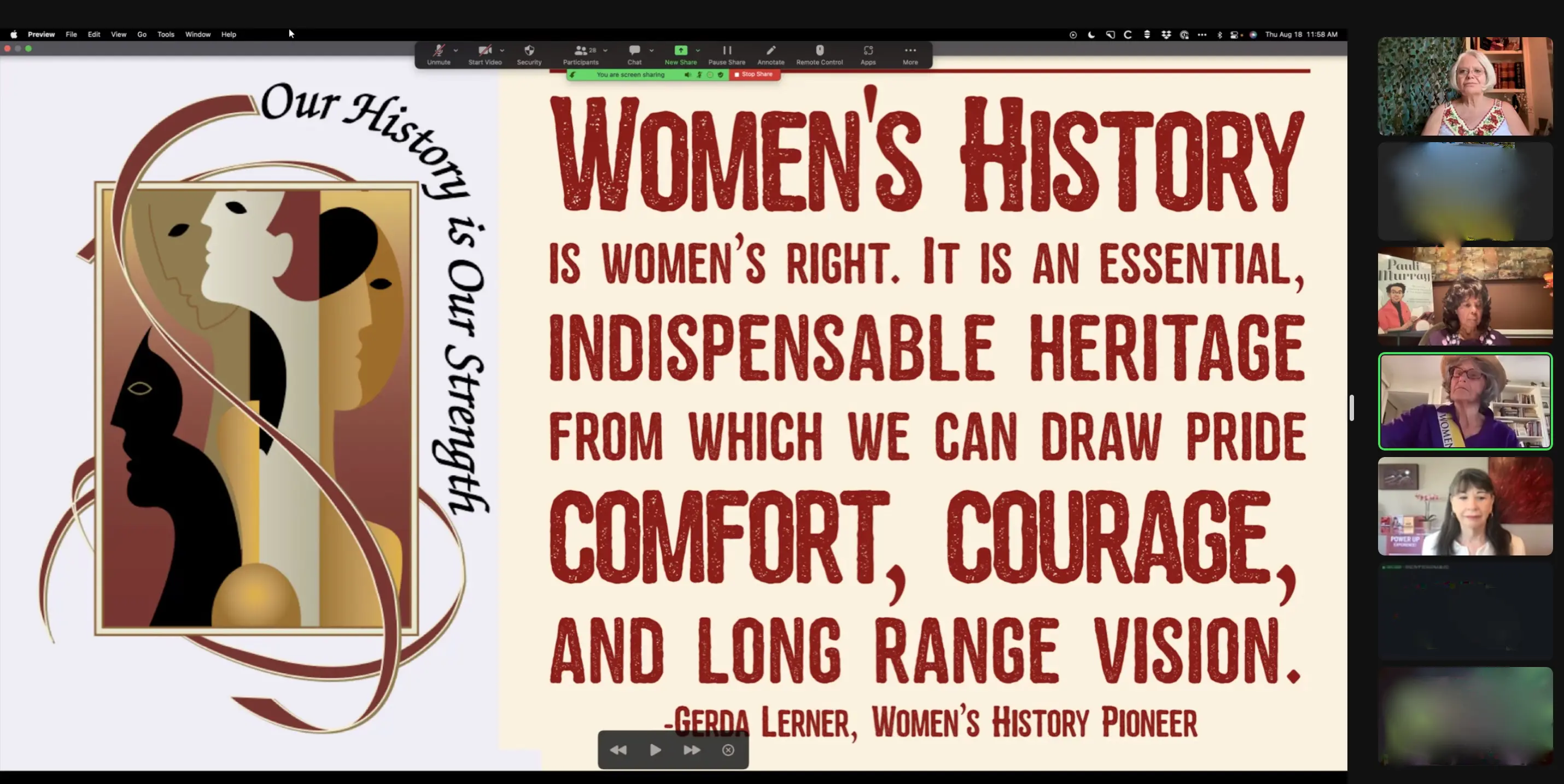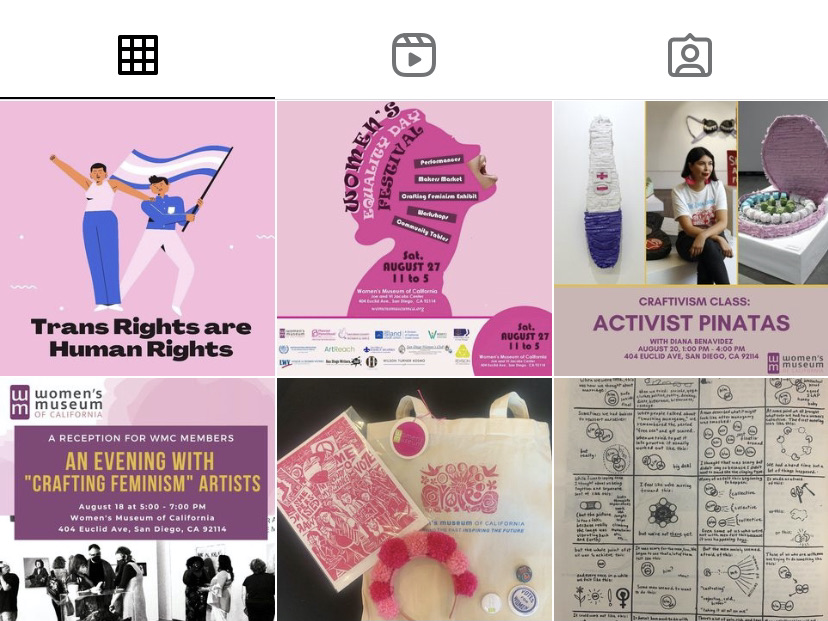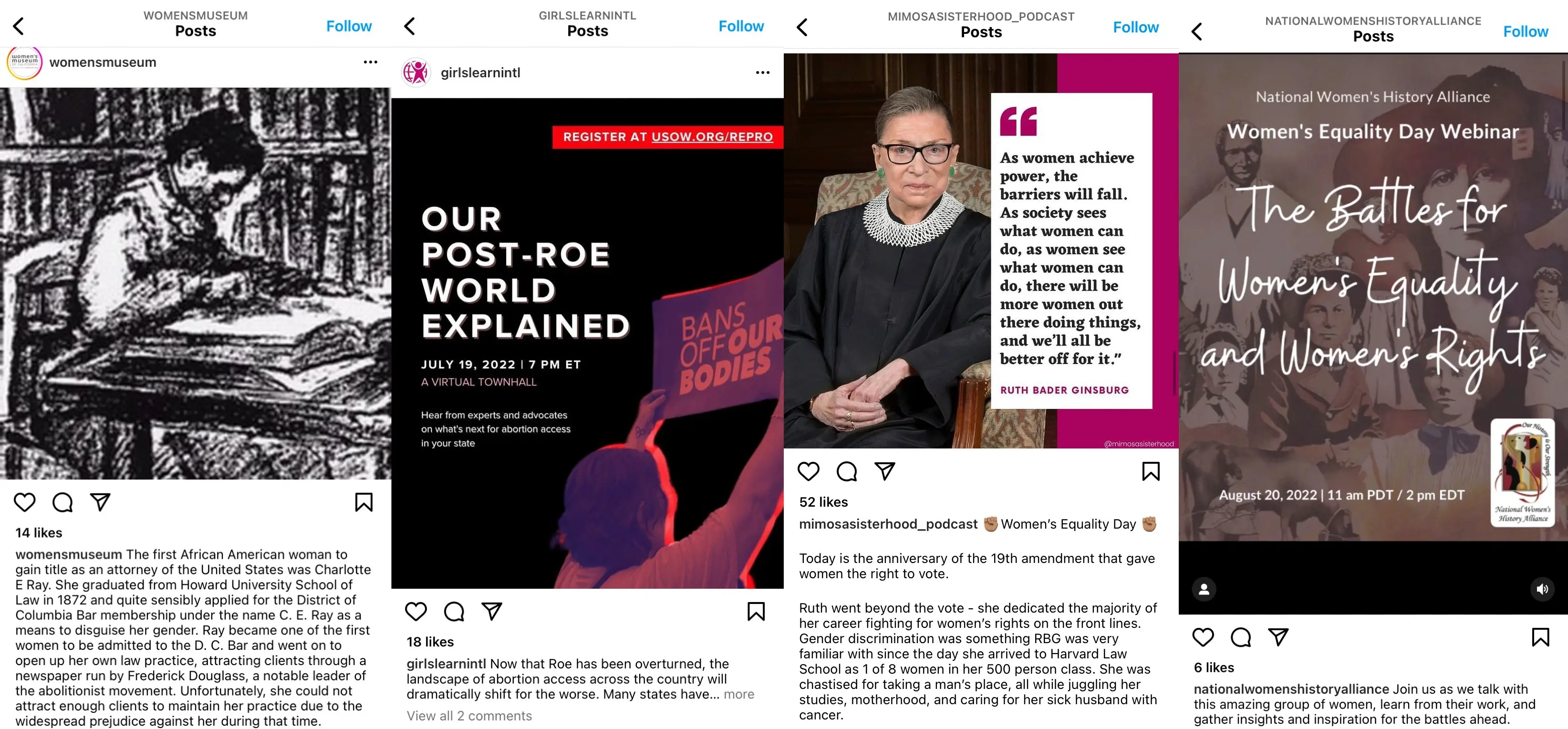
I. Creating change for the feminist movement one post at a time
When Melissa Jones joined the Women’s Museum of California, she had just finished an internship that taught her how to use social media. Out of curiosity, she decided to check out the museum's social media presence and discovered that they had few posts and only approximately 100 followers.
Realizing that the Women’s Museum could enhance its social media presence, Jones began managing their accounts in the summer of 2015 and later became the director of marketing in 2016. She built the account to engage with more people and posted consistently about museum events, historical commemorative days, museum exhibit archives, and calls to action. She also explained the museum’s mission and shared information and stories about women’s history hoping that developing their social media pages would encourage a wider audience to visit the museum to learn more.
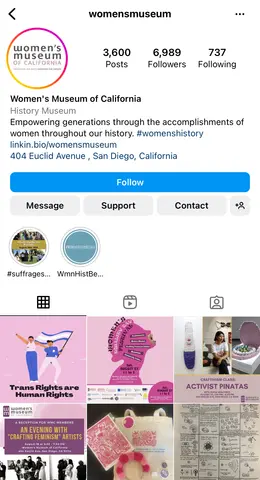
With a mission to “educate and inspire present and future generations about the experiences and contributions of diverse women by collecting, preserving, and interpreting their stories,” Jones also attempts to provide historical context when responding to current events in the news.
Social media can be capable of advancing the feminist movement by bringing greater visibility to women’s rights issues, facilitating effective communication, aiding people in organizing, educating people on women’s history and current events, and inspiring people to become activists in the fight for greater equality. Yet social media can also potentially undermine the movement through online harassment and disinformation, constant self-comparisons and body image issues driven by societal beauty standards, and weakened critical thinking.
Through social media, Jones, Allison Munder of Girls Learn International, Ellen Snortland of the National Women’s History Alliance, and Melissa Herrera of the Mimosa Sisterhood podcast created ways to utilize their platforms to contribute to the advancement of women.
Visibility and greater awareness of women’s issues
One benefit the women found was attaining greater visibility for their organizations and causes through marketing and maintaining a public presence.
“We use social media to primarily promote our organization and hopefully attract new visitors to our museum and for our followers on social media to build appreciation for women's history,” Jones said.
She discovered that building the museum’s social media pages and content has been useful in informing the public of who they are and how to visit them while creating the ability for the museum to exist beyond a physical space.
Before Allison Munder became the chapter development associate of Girls Learn International (GLI), the organization already had Instagram and Facebook accounts. However, once the pandemic hit, she realized that, in order to train and empower high school and middle school students to be future leaders who advocate for human rights and greater equality, GLI needed to be more active on social media and increase their virtual interactions with the students.
In developing the page’s content, Munder asks the students what they want to know and what they need while also examining current events that could impact students directly.
“A lot of the time the news forgets about these events and we want to bring them up and make sure they’re constantly in conversation,” Munder said.
Ellen Snortland has been a board member of the National Women’s History Alliance (NWHA) since 2019, and she has advocated for women’s rights for decades. The mission of the organization is to “bring women’s history into the classroom and into people’s consciousness.” Similar to other organizations, NWHA recognized the importance of creating social media accounts to maintain a presence with posts that encourage people to attend their educational events.
Unlike Jones, Munder, and Snortland, Melissa Herrera, host and creator of the podcast Mimosa Sisterhood, has found social media to be less helpful than she initially imagined.
“I feel like the podcast is my main source of media where I am most active because it’s where I produce and release the content that I’m creating,” Herrera said. “But in order to try and build an audience or get visibility and attract new listeners, I have to utilize social media. And that is a whole ball game that is very challenging.”

In spite of her struggles, Herrera has still found ways to use social media to contribute to her mission. Through the podcast, she strives to create a space where she could share and bring greater visibility to women’s stories, educate the public on the female experience, and cultivate greater empathy. The main themes of the show include women’s history, historical facts, quotes from women in history and women making history now, and her own life experiences.
Building communities by promoting resources, sharing information, and facilitating communication
Beyond establishing greater visibility, social media helps organizations like GLI share valuable resources about activism to encourage people to organize. Munder of GLI often disseminates information on current events and provides resources describing how her students could take action on issues that directly impact their lives, showing how online communities can be built.
“We’ve been so siloed and made invisible by traditional forms of media that social media has allowed a lot of people to see, ‘Oh my goodness. I’m not the only one.’ So that’s a very powerful part of social media,” Snortland of NWHA said.
In enhancing an individual’s ability to build a community, social media has also aided these organizations in reaching people outside state or even country lines.
“We can communicate and educate and inspire not just people throughout the state of California, but across the United States, and even engage with people around the world who really care about women’s empowerment and women’s history,” Jones from the Women’s Museum said.
With the extensive reach of social media, people are further able to engage in more efficient and effective communication. Dr. Rebecca Jo Plant, professor of history at the University of California, San Diego, explained that social media facilitates rapid communication that allows people to organize more effectively in large numbers than what may have been possible in the past.
In the book, They Didn't See Us Coming: The Hidden History of Feminism by Lisa Levenstein, professor of history at the University of North Carolina Greensboro and director of the Women’s, Gender, and Sexuality Studies Program, Levenstein explained that feminists often "saw computers as the successors to the tools that previous generations of feminists had used to circumvent the mainstream media and communicate with one another."
A multitude of causes dedicated to advocating for women’s rights have also gained support worldwide with the help of social media. A few of the movements listed in the article “Hashtag women’s rights: 12 social media movements you should follow” from UN Women in 2019 include #MeToo, #TimesUp, #NiUnaMenos, #HeforShe, #BringBackOurGirls, #EverydaySexism, #YesAllWomen, and #IWillGoOut, each of which worked toward the advancement of gender equality and brought greater awareness of the issues that women face.
A UN Women article from 2018 states, “As women’s activism around #Metoo, #TimesUp #NiUnaMenos and other movements continue to build, social media is giving women a space to speak up and be heard.”
Education, calls to action, and empowerment
All four women also identified ways to use their accounts to educate the public and inform them of current events and issues related to the feminist movement.
“Often what we hear too is, through our social media posts or blog posts, ‘Oh thank you so much. I never knew about this,’” Jones said.
She recalled one particularly memorable instance when she published a post indicating that "The New Colossus" poem at the Statue of Liberty poem was written by a woman.
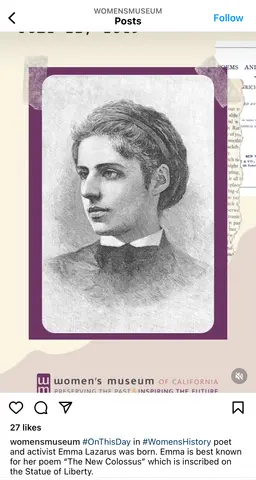
“Every time people go, ‘I can’t believe I didn’t know that,’ which isn’t really anyone’s fault because the reason we exist is because we’re not taught women’s history in schools… ,” Jones said. “So when people tell us that they’re grateful, that they’ve learned something new today, or just this overwhelming sense of they didn’t know how much they didn’t know before, then hopefully that inspires them to just rethink other things they didn’t know they didn’t know, and that they can go on and read more and learn more from being inspired by the posts that they read.”
Snortland of NWHA expanded on how learning more about women’s history could help create another generation of activists.
“Women’s history is inspiring, and actually, I love pissing women off because a lot of women when they come up against and finally learn about stuff, it’s like, ‘Why didn’t I know this? Why didn’t I know this?’ And then it leads them down a path of really discovering just how sexist this culture is. That these women who gave their lives, that gave their heart and soul to advancing women have just been relegated to the dustbin of history,” Snortland said.
Recently, Munder has been using GLI’s social media to share valuable information about Roe v. Wade and ways to access abortions.
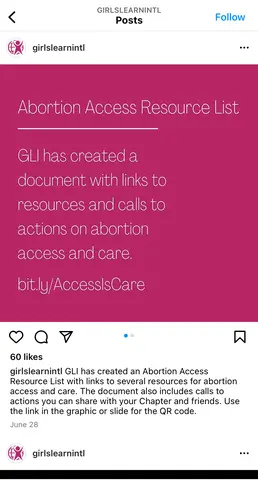
“I think social media and technology have advanced feminism and humans rights by showing people what’s happening, and then providing them with resources, and giving people actions to do,” Munder said.
In this sense, social media gives more people a voice to inform those around them of the challenges that people face and advocate for issues that are important to them. In the past, Snortland explained that if editors decided that a certain topic, event, or action was not newsworthy, the content would not be distributed.
“We as independent generators of content can decide what’s newsworthy without having to go through a middle guy, a middle woman,” Snortland said.
According to a Pew Research Center data report published in April 2021, “A little under half (48%) of U.S. adults say they get news from social media ‘often’ or ‘sometimes.’” With 48% of the population looking to social media for their news, social media accounts that promote feminism have attained the opportunity to reach an even wider audience.
By using social media to educate the public about the stories of the past and current events, these women are also inspiring others to advocate for women’s rights.
“When you look back on some of these stories and the things that they were facing and fighting against, I think it’s the most empowering thing to be consuming right now because if we’re not feeling the desire to stand up and do something, we should be,” Herrera of Mimosa Sisterhood said. “And I think that if anybody’s struggling to find that within themselves … if you hear some of these stories of what people have done before you even existed on the planet and understand that they went through that so that us today could live a better life that they didn’t have, it is the most powerful feeling in the world because, in a sense, you feel like the ancestors that have come before you not only did part of the work, but they paved the way for you to finish it, and that’s where we’re at right now.”
II. The consequences of a virtual world
During Melissa Jones’ time as the director of marketing at the Women’s Museum of California, the museum's social media page has received death threats and negative comments on their posts meant to incite arguments. Their account has received backlash on numerous issues including but not limited to equal pay, trans rights, and trans women, and they have also been accused of being a sexist organization.
The Women’s Museum’s account is just one of many that have experienced the negativity that comes with social media. While social media enhances the ability of Jones, Snortland, Munder, and Herrera to advocate for the feminist movement, they also recognize and encounter numerous challenges.
Harassment, threats, bots, and trolls
One such challenge is online harassment, including dangerous threats, made worse by trolls and bots.
“We’ve had to report people who have left threats on our social media posts, so I can only imagine if you’re an individual who’s trying to advocate for change, trying to advocate for gender equality, and you receive these same types of comments that we do, and you don't have the same resources as we do as an organization … I could definitely see how scary and damaging that would be,” Jones said.
These threats and harmful comments crossing the line of harassment can cause people to question their own safety and could discourage them from wanting to stand for their beliefs and become activists. Worsening the issue, Jones explained, are trolls and specific groups of people that exist to stalk and monitor certain hashtags relating to feminism and women’s rights, posting negative, misogynistic responses on those pages.
“Because they can be anonymous, they ramp up their ugliness,” Snortland explained. “You have to have thick skin to hold up against the mobs, virtual mobs.”
Rigid perspectives and unforgiving culture
Munder of GLI explains that numerous people seem to believe their perspective is the only “correct” way to consider an issue.
“The way things are worded on social media or the way people like to be like, ‘No, I’m more of a feminist than you are,’ is negatively impacting the feminist community,” Munder said.
This rigidity shown by those who believe their perspective is the only one that counts is further reflected in social media’s often unkind and unforgiving culture when an individual makes a mistake.
“I also think that we tend to police a lot of if you say the wrong thing, there’s no way of going back, and I think it’s really important to, instead of lecturing people online, to educate people online,” Munder said. “It’s really important to make sure that we’re helping people evolve and not being like, ‘Oh they’re wrong. They’re never going to learn,’ and kind of exclude them from our conversation.”
Disinformation and misinformation
Disinformation is another problem that runs rampant on social media. Jones found that some people create fake accounts or bots designed to spread disinformation. Even within the political sphere, Munder commented that she has seen politicians spreading false information about reproductive rights and how a woman’s body works, which is then circulated by their followers.
“I’m horrified by the state we are in right now in our country, and I think that the internet is not exclusively, but largely responsible for people being completely unable to distinguish between truth and fantasy and think for themselves,” said Dr. Nina Gelbart, professor of history and Anita Johnson Wand Professor of Women's Studies at Occidental College in Los Angeles.
Social media further exacerbates the natural issue humans already have with identifying the truth in a sea of disinformation through its enhancement of the psychological concept known as the availability heuristic. In The Social Animal, social psychologists Elliot Aronson and Joshua Aronson write, “The availability heuristic is usually benign and often useful, but it has a dark disadvantage when it leads us to decide what is true and right not based on a claim's logical merit but on its ease of retrieval: an unintended hazard of the internet is that everything from conspiracy claims to pseudoscientific medical advice, endlessly repeated, can flourish unchecked".
False sense of expertise
Jones is concerned that many people now feel they are experts on women’s issues without having the knowledge or experience required to be one.
“You might just be seeing the tip of an iceberg on a conversation in social media, and then feel like you are now an expert and know everything about it. But in fact, you just saw a little entry level sentence on a topic …,” Jones said. “Now everyone thinks they’re the expert because they read an Instagram post on a topic without knowing … what the credentials or the backgrounds of these posts are.”
The moral issue
On a moral level, Jones of the Women’s Museum and Herrera of Mimosa Sisterhood noted that, although social media is needed to maintain their presence, it is difficult to support the corporations and people running social media companies who differ from their ideologies.
“So it’s like we don’t really want to support Facebook because we don’t really like what they’re doing in terms of affecting people's self-esteem and their anxiety and their sense of self worth and body dysmorphia, especially on Instagram, but if we don’t use it, we don’t exist in this 21st century digital world,” Jones said.
Beauty standards and body image issues
Beyond these problems, social media also creates numerous insecurities and body image issues for women. In 2021, the Wall Street Journal published a series known as “The Facebook Files” that discussed company documents released by Frances Haugen and how Facebook was aware of the damaging issues of its social media sites. Within the series, one article reveals how Instagram is especially harmful for teenage girls through social comparisons, exacerbation of body image issues, and mental health problems.
Herrera also noted that while some pages produce beneficial content, others negatively influence how young girls perceive themselves. Herrera compared how her time as a 10-year-old playing soccer is vastly different than that of today’s girls who see influencers using their bodies to sell products—sending messages to those of an impressionable age that their value and worth is dependent on their appearance.
Munder expands upon the concern of unrealistic comparisons and expectations. “I see it a lot with young teenagers who admire people who don’t actually look the way that they look in real life. So that impacts their insecurities, and they think that they have to hold the same persona,” Munder said.
Dr. Sophia Choukas-Bradley, assistant professor of psychology at the University of Pittsburgh and licensed clinical psychologist, studies the impact of social media on body image issues as the director of the Teen and Young Adult Lab. Her lab found that social comparison in the form of comparing photos increases self-objectification and worsens body image.
Munder added that social media often only exhibits the good parts of people's lives, which is problematic because at a young age, one may not recognize that people are not “perfect” all of the time.
Choukas-Bradley noted that when people view edited photos, they are more likely to partake in upward social comparisons, which is made worse when people use filters and editing applications to create these fake, ideal personas. While this issue already existed with edited photos in the mainstream media, she noted that greater universal access to editing tools exacerbates the false idea that everyone fits societal beauty standards.

Choukas-Bradley also revealed how social media promotes traditional societal beauty standards through incentivizing becoming an influencer. “...[B]efore social media, there was no mechanism through which an ‘everyday person’ could just take photos of oneself, distribute them broadly, and make a ton of money, but now . . . there are cases of people becoming rich and famous by perpetuating these beauty standards both through editing their images and engaging in a whole range of behaviors sometimes including surgeries and really restrictive cosmetic routines… ”
Dr. Janet Tomiyama, professor of psychology at the University of California, Los Angeles, noted that weight stigma is especially prevalent on social media.
“There are clinically diagnosable eating disorders, … like anorexia nervosa …, but what I think sometimes gets overlooked are disordered eating behaviors and thoughts that a lot of people can have even if they don’t have an eating disorder,” Tomiyama explained.
She mentioned severe dieting, laxatives, diet pills, and one-off binge eating as just a few ways this disordered eating could take form. She also explained that people fat-shame others in the social media comments sections, which could put people at risk of engaging in disordered eating behavior.
The loss of critical thinking and reflection
While Gelbart of Occidental College acknowledges that the efficiency of communication that is achieved through social media could be beneficial to the feminist movement, she has also discovered that there appears to be a loss of reflection and critical thinking due to the speed at which humans are receiving information.
“I just think that we have to pay attention to what’s going on around us. We have to take a pause, a big long pause from our screens,” Gelbart said. “We have to think for ourselves. … We have to disconnect from what other people think so that we can be more powerful agents in the feminist movement and not just go along with the crowd.”
With a constant influx of information and self-comparisons, Gelbart is also concerned about how social media’s focus on approval and validation impacts the development of young women.
“I think that social media has been very harmful and very destructive to young women as they think about who they are, what they want to be, and I think that it undermines their ability to think as individuals,” Gelbart said.
Plant of the University of California, San Diego shares a similar concern for society saying, “... mostly for me, this comes through as nobody reads anymore…. They just want sound bites. They don’t want to engage in real sustained thoughts or trace the development of an idea to really deeply understand its history, to engage in a more complex exchange. I find that very frustrating …”
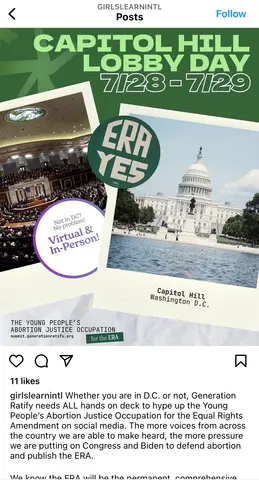
Instead, Gelbart has found that actions in the real world are more effective in creating social and political change.
“I would rather see people attending and contributing to fundraisers. I’d rather see people out marching and protesting. I’d rather see people volunteering for social change to reject chauvinism, to reject racism. I think that actions are way more significant than texts,” Gelbart said.
Where do we go from here?
While social media appears to contribute to the feminist movement and society in various ways, both helpful and harmful, Plant has found that society is still unclear on the best way to manage social media and who should determine the guidelines for how it is used.
“I think that social media is most effective when … it’s actually used to facilitate getting people to show up physically…,” Plant said.
If everyone were to remain solely within the virtual world, who would stand to make a change in the real world?
“It’s not just about retweeting things or resharing those black boxes on Instagram and thinking ‘Oh great, I’m an activist.’ It’s having those calls to action that is so essential,” Jones from the Women’s Museum said.
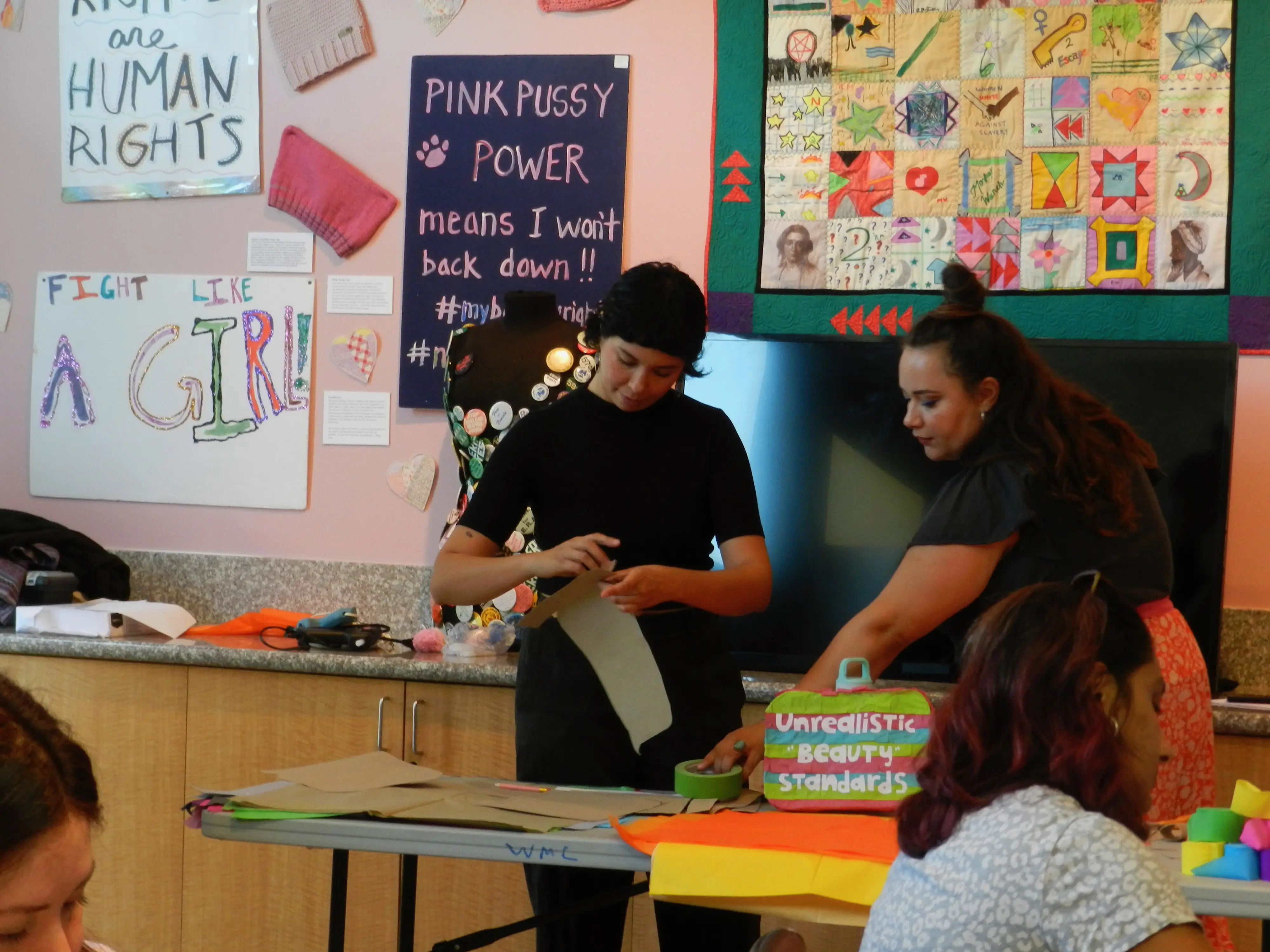
It is up to society to critically analyze current means of activism and discover how they can most effectively advocate for issues and create change.
“You’ve learned all this stuff, . . . and now we’re going to put that passion to action, and you’re going to honor our history of social change, of promoting gender equality, and you’re going to be part of that new history,” Jones said. “Because what we want to do is inspire future generations to take up that mantle and continue on this journey because it is not over.”
“Not only were we dealt a bad hand, but people are cheating. This game has been rigged,” Snortland said. “And when people wake up to that, then they become activists, which is what we need. And right now especially with this Supreme Court, we’re in danger. We are in danger, and I want women to understand that this is significant.”
